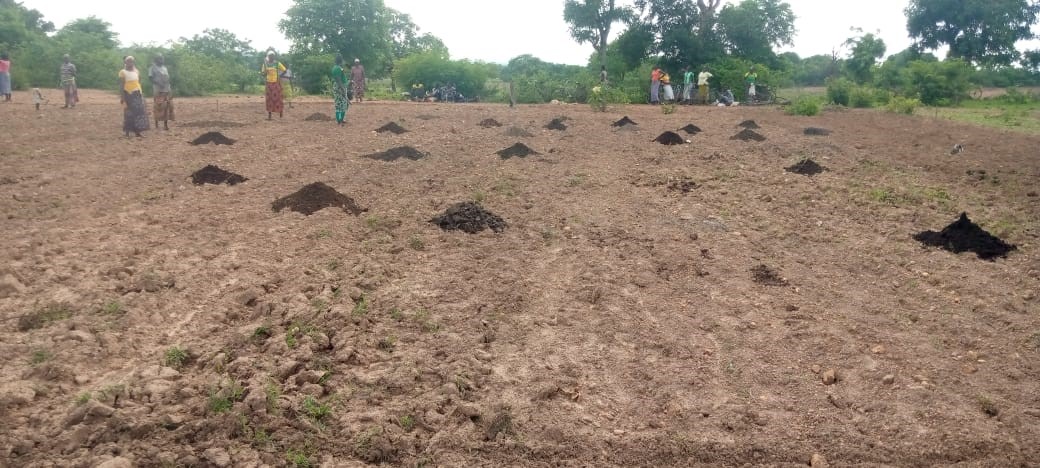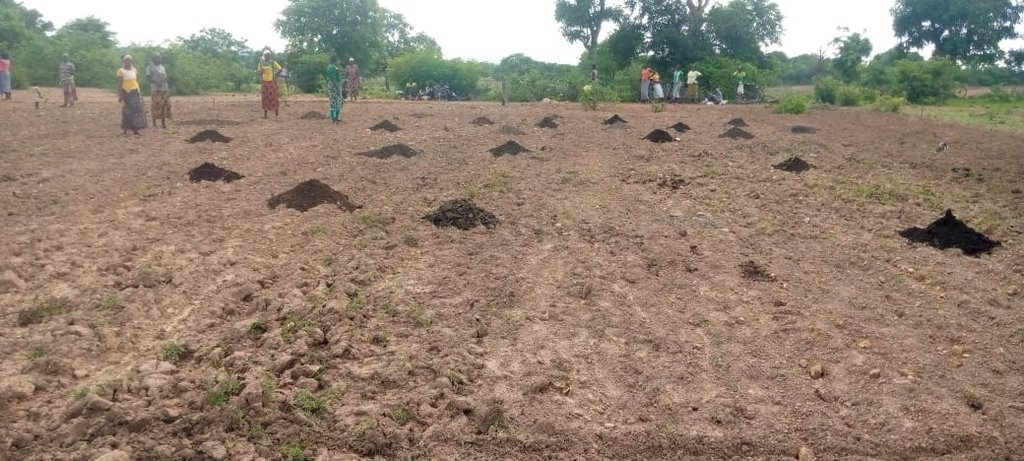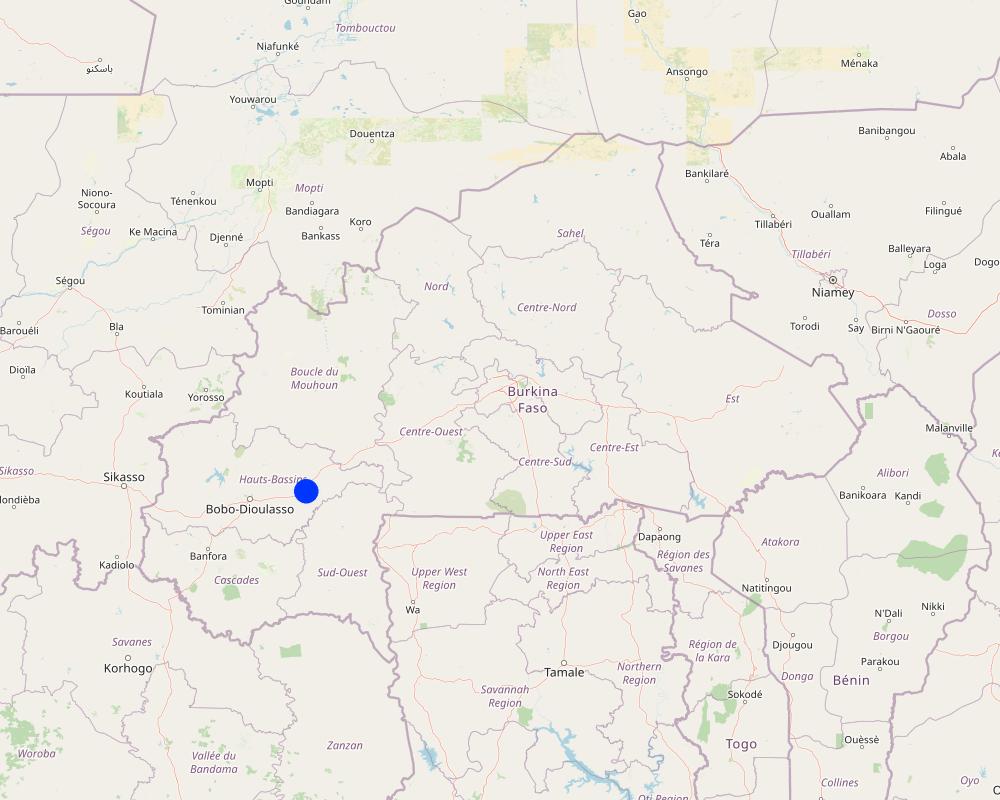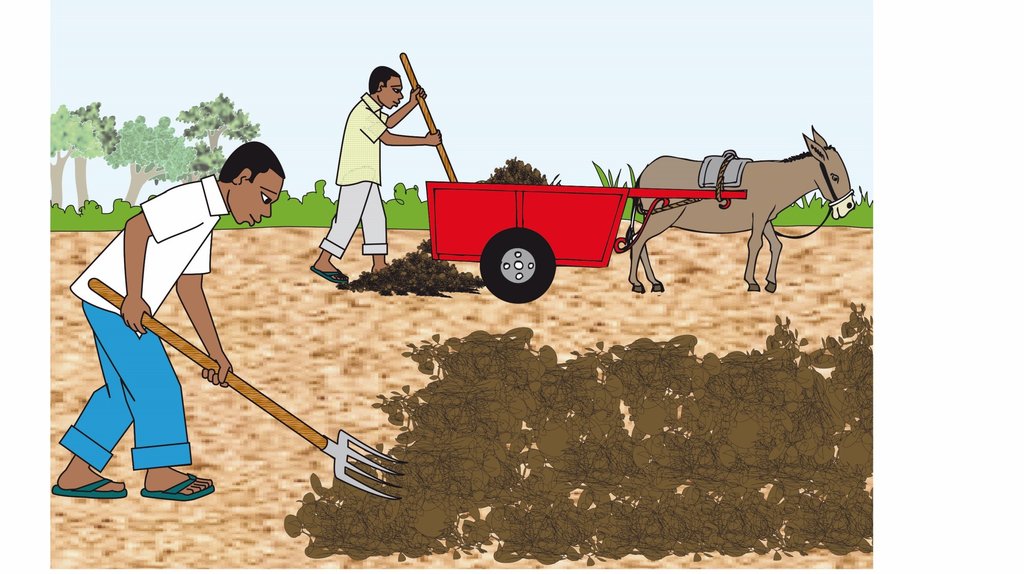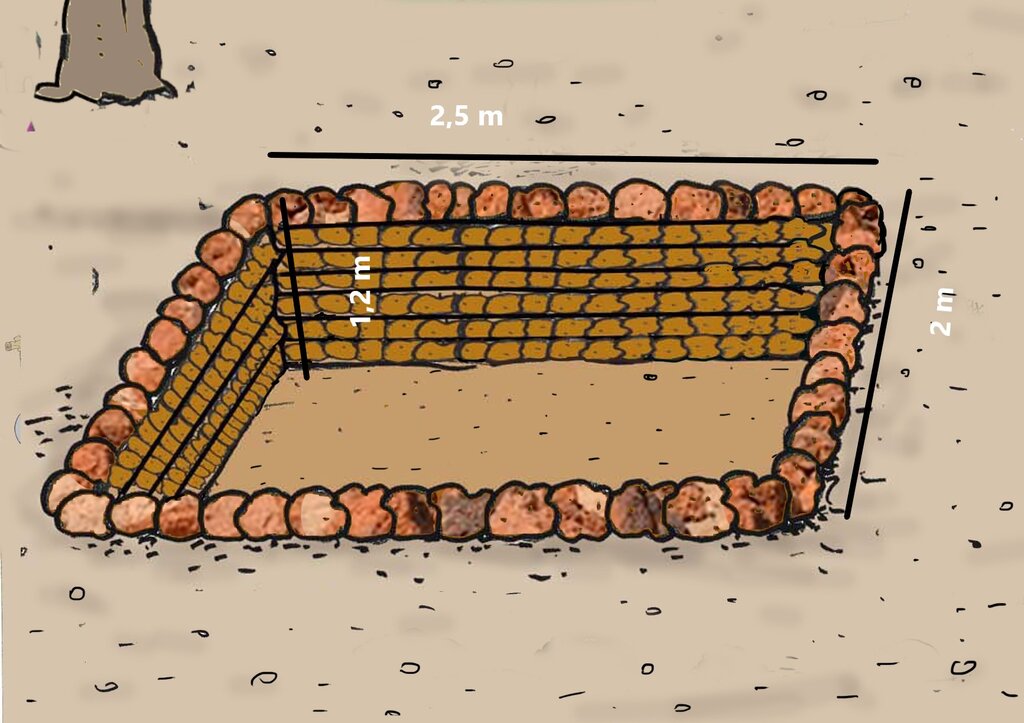Fertilisation par la fumure organique [Burkina Faso]
- Creation:
- Update:
- Compiler: Moussa ABOU
- Editors: Brice Sosthène BAYALA, Siagbé Golli
- Reviewers: Sally Bunning, Rima Mekdaschi Studer
technologies_6704 - Burkina Faso
View sections
Expand all Collapse all1. General information
1.2 Contact details of resource persons and institutions involved in the assessment and documentation of the Technology
Key resource person(s)
land user:
OUEDRAOGO Abdoulaye
Burkina Faso
land user:
KABORE Abdoul Nassirou
Burkina Faso
Name of project which facilitated the documentation/ evaluation of the Technology (if relevant)
Soil protection and rehabilitation for food security (ProSo(i)l)Name of the institution(s) which facilitated the documentation/ evaluation of the Technology (if relevant)
Deutsche Gesellschaft für Internationale Zusammenarbeit (GIZ)1.3 Conditions regarding the use of data documented through WOCAT
The compiler and key resource person(s) accept the conditions regarding the use of data documented through WOCAT:
Yes
1.4 Declaration on sustainability of the described Technology
Is the Technology described here problematic with regard to land degradation, so that it cannot be declared a sustainable land management technology?
No
2. Description of the SLM Technology
2.1 Short description of the Technology
Definition of the Technology:
La fertilisation par la fumure organique est un amendement humifère. C’est une technologie d’amendement du sol qui permet d’améliorer la structure et la fertilité du sol pour améliorer sa qualité de production.
2.2 Detailed description of the Technology
Description:
La fumure organique est un engrais organique qui a pour objectif d’enrichir les sols. De ce point de vue, Elle s’applique dans les champs qui connaissent une baisse de la fertilité de leurs sols. C’est une technologie appliquée sur les espaces agricoles en zone intertropicale.
La fertilisation par la fumure organique est un procédé qui consiste à enrichir les sols par des apports de matières organiques suffisantes et par l’amélioration des qualités physico-chimiques de la terre. Pour la mise en application de cette technologie en cultures de céréales, il est recommandé dans le cadre des bonnes pratiques agricoles, d’apporter 5 à 6 tonnes de fumure organique bien décomposée par hectare en première année, puis 500 à 600 kg les années suivantes. L’apport en fumure organique se fera par épandage, notamment l’épandage uniforme. Cette technique consiste à mettre le compost en tas sur la parcelle de façon uniforme et à l’enfouir lors du labour.
La fertilisation par la fumure organique a pour objectifs d’enrichir les sols à travers l’apport de matières organiques suffisantes, l’amélioration des qualités physico-chimiques de la terre et la préservation de la texture des matières minérales comme le sable et l'argile. Elle permet d’améliorer la structure et la fertilité du sol et l’augmentation des rendements.
Les principales activités de la fertilisation par la fumure organique sont les suivantes :
•la production de la fumure organique ;
•le transport de la fumure organique ;
•l’épandage de la fumure organique ;
•le mélange au sol par labour.
Les intrants majeurs nécessaires à la mise en place de cette technologie sont :
•la fumure organique ;
•les charrettes ;
•les brouettes ;
•les pioches ;
•les pelles ;
•les râteaux.
La fertilisation par la fumure organique permet d’améliorer la qualité du sol, de retenir l’eau et de nourrir les plants. Elle a pour impacts la croissance des cultures et l’augmentation des rendements.
Les exploitants affirment que cette technologie améliore la qualité du sol. Toutefois, elle comporte des contraintes telles que les difficultés de transformation des matériaux organiques et de transport de la fumure organique.
2.3 Photos of the Technology
2.5 Country/ region/ locations where the Technology has been applied and which are covered by this assessment
Country:
Burkina Faso
Region/ State/ Province:
Région des Hauts-Bassins (Province du Tuy)
Further specification of location:
Koumbia (Commune de Koumbia)
Specify the spread of the Technology:
- applied at specific points/ concentrated on a small area
Is/are the technology site(s) located in a permanently protected area?
No
Map
×2.6 Date of implementation
Indicate year of implementation:
2019
If precise year is not known, indicate approximate date:
- less than 10 years ago (recently)
2.7 Introduction of the Technology
Specify how the Technology was introduced:
- through projects/ external interventions
Comments (type of project, etc.):
La technologie a été introduite par le Chef de la Zone d'Appui Technique (ZAT) en agriculture) de la commune de Koumbia.
3. Classification of the SLM Technology
3.1 Main purpose(s) of the Technology
- improve production
- reduce, prevent, restore land degradation
- create beneficial economic impact
3.2 Current land use type(s) where the Technology is applied
Land use mixed within the same land unit:
Yes
Specify mixed land use (crops/ grazing/ trees):
- Agroforestry

Cropland
- Annual cropping
- Tree and shrub cropping
Annual cropping - Specify crops:
- cereals - other
- cereals - maize
- cereals - sorghum
Tree and shrub cropping - Specify crops:
- karite (sheanut)
- grapes
Number of growing seasons per year:
- 1
Is intercropping practiced?
No
Is crop rotation practiced?
Yes
If yes, specify:
Coton, sorgho et maïs.
3.3 Has land use changed due to the implementation of the Technology?
Has land use changed due to the implementation of the Technology?
- No (Continue with question 3.4)
3.4 Water supply
Water supply for the land on which the Technology is applied:
- rainfed
3.5 SLM group to which the Technology belongs
- integrated soil fertility management
3.6 SLM measures comprising the Technology

agronomic measures
- A2: Organic matter/ soil fertility
- A3: Soil surface treatment
A3: Differentiate tillage systems:
A 3.3: Full tillage (< 30% soil cover)
3.7 Main types of land degradation addressed by the Technology

soil erosion by water
- Wt: loss of topsoil/ surface erosion

chemical soil deterioration
- Cn: fertility decline and reduced organic matter content (not caused by erosion)

biological degradation
3.8 Prevention, reduction, or restoration of land degradation
Specify the goal of the Technology with regard to land degradation:
- reduce land degradation
4. Technical specifications, implementation activities, inputs, and costs
4.1 Technical drawing of the Technology
Technical specifications (related to technical drawing):
•5 à 6 tonnes de fumure organique bien décomposée par hectare en première année ;
•Fosse de 6m3 correspond à environ 4,5 tonnes de fumure organique, suffisantes pour 0,9 ha sur la base d’un apport de 5 tonnes/ha ;
•500 à 600 kg les années suivantes ;
•Épandage uniforme.
Author:
ProSol/GIZ
Date:
2021
Technical specifications (related to technical drawing):
•Longueur de la fosse : 2,5 m ;
•Largeur de la fosse : 2 m ;
•Profondeur de la fosse de : 1,2 m ;
•Volume de la fosse de 6 m3.
Author:
ProSol/GIZ
Date:
2021
4.2 General information regarding the calculation of inputs and costs
Specify how costs and inputs were calculated:
- per Technology unit
Specify unit:
Fosse
Specify dimensions of unit (if relevant):
10,8 m3
If relevant, indicate exchange rate from USD to local currency (e.g. 1 USD = 79.9 Brazilian Real): 1 USD =:
613.5
Indicate average wage cost of hired labour per day:
2000 FCFA
4.3 Establishment activities
| Activity | Timing (season) | |
|---|---|---|
| 1. | Production de la fumure organique | Saison sèche |
| 2. | Transport de la fumure organique | Saison sèche |
| 3. | Epandage de la fumure organique | Saison sèche |
| 4. | Mélange au sol par labour | Saison des pluies |
4.4 Costs and inputs needed for establishment
| Specify input | Unit | Quantity | Costs per Unit | Total costs per input | % of costs borne by land users | |
|---|---|---|---|---|---|---|
| Labour | Main d'oeuvre | Fosse | 1.0 | 35000.0 | 35000.0 | 100.0 |
| Equipment | Pic à gaz | Nombre | 1.0 | 35000.0 | 35000.0 | 100.0 |
| Equipment | Pelle | Nombre | 1.0 | 2000.0 | 2000.0 | 100.0 |
| Equipment | Râteau | Nombre | 1.0 | 5000.0 | 5000.0 | 100.0 |
| Equipment | Brouette | Nombre | 1.0 | 30000.0 | 30000.0 | 100.0 |
| Plant material | Fourche | Nombre | 1.0 | 3000.0 | 3000.0 | 100.0 |
| Plant material | Arrosoir | Nombre | 1.0 | 2000.0 | 2000.0 | 100.0 |
| Plant material | Charrette | Nombre | 1.0 | 125000.0 | 125000.0 | 100.0 |
| Construction material | Ciment | Sac | 3.0 | 6500.0 | 19500.0 | 100.0 |
| Construction material | Brique | Nombre | 90.0 | 525.0 | 47250.0 | 100.0 |
| Other | Eau | Barrique | 20.0 | 750.0 | 15000.0 | 100.0 |
| Total costs for establishment of the Technology | 318750.0 | |||||
| Total costs for establishment of the Technology in USD | 519.56 | |||||
4.5 Maintenance/ recurrent activities
| Activity | Timing/ frequency | |
|---|---|---|
| 1. | Arrosage | Saison sèche |
| 2. | Retournement du tas | Saison sèche |
4.6 Costs and inputs needed for maintenance/ recurrent activities (per year)
| Specify input | Unit | Quantity | Costs per Unit | Total costs per input | % of costs borne by land users | |
|---|---|---|---|---|---|---|
| Labour | Arrosage | Fosse | 1.0 | 12000.0 | 12000.0 | 100.0 |
| Labour | Retournement du tas | Nombre | 6.0 | 2000.0 | 12000.0 | 100.0 |
| Total costs for maintenance of the Technology | 24000.0 | |||||
| Total costs for maintenance of the Technology in USD | 39.12 | |||||
4.7 Most important factors affecting the costs
Describe the most determinate factors affecting the costs:
Le coût de la main d’œuvre, du petit matériel nécessaire ainsi que le coût du transport constituent les principaux facteurs affectant la mise en œuvre de cette technologie.
5. Natural and human environment
5.1 Climate
Annual rainfall
- < 250 mm
- 251-500 mm
- 501-750 mm
- 751-1,000 mm
- 1,001-1,500 mm
- 1,501-2,000 mm
- 2,001-3,000 mm
- 3,001-4,000 mm
- > 4,000 mm
Specify average annual rainfall (if known), in mm:
900.00
Specifications/ comments on rainfall:
Le climat de la région des Hauts bassins dont relève le village de Koumbia (commune de Koumbia) est tropical de type nord-soudanien et sud soudanien. Ce climat est marqué par deux (02) grandes saisons : une saison humide qui dure 06 à 07 mois (mai à octobre/novembre) et une saison sèche qui s'étend sur 05 à 06 mois (novembre/décembre à avril).
Indicate the name of the reference meteorological station considered:
Poste pluviométrique de Koumbia
Agro-climatic zone
- sub-humid
Les températures moyennes varient entre 24°c et 30°c avec une amplitude thermique relativement faible de 5°c.
5.2 Topography
Slopes on average:
- flat (0-2%)
- gentle (3-5%)
- moderate (6-10%)
- rolling (11-15%)
- hilly (16-30%)
- steep (31-60%)
- very steep (>60%)
Landforms:
- plateau/plains
- ridges
- mountain slopes
- hill slopes
- footslopes
- valley floors
Altitudinal zone:
- 0-100 m a.s.l.
- 101-500 m a.s.l.
- 501-1,000 m a.s.l.
- 1,001-1,500 m a.s.l.
- 1,501-2,000 m a.s.l.
- 2,001-2,500 m a.s.l.
- 2,501-3,000 m a.s.l.
- 3,001-4,000 m a.s.l.
- > 4,000 m a.s.l.
Indicate if the Technology is specifically applied in:
- convex situations
Comments and further specifications on topography:
Le site évalué est situé à une altitude de 348 m.
5.3 Soils
Soil depth on average:
- very shallow (0-20 cm)
- shallow (21-50 cm)
- moderately deep (51-80 cm)
- deep (81-120 cm)
- very deep (> 120 cm)
Soil texture (topsoil):
- coarse/ light (sandy)
- fine/ heavy (clay)
Soil texture (> 20 cm below surface):
- coarse/ light (sandy)
- fine/ heavy (clay)
Topsoil organic matter:
- medium (1-3%)
If available, attach full soil description or specify the available information, e.g. soil type, soil PH/ acidity, Cation Exchange Capacity, nitrogen, salinity etc.
Les principaux sols sont les sols de types ferrugineux tropicaux lessivés plus ou moins sablonneux en terres hautes et des sols argileux plus ou moins hydromorphes dans les bas-fonds.
5.4 Water availability and quality
Ground water table:
5-50 m
Availability of surface water:
good
Water quality (untreated):
poor drinking water (treatment required)
Water quality refers to:
both ground and surface water
Is water salinity a problem?
No
Is flooding of the area occurring?
No
5.5 Biodiversity
Species diversity:
- medium
Habitat diversity:
- medium
5.6 Characteristics of land users applying the Technology
Sedentary or nomadic:
- Sedentary
Market orientation of production system:
- mixed (subsistence/ commercial)
Off-farm income:
- less than 10% of all income
Relative level of wealth:
- average
Individuals or groups:
- individual/ household
Level of mechanization:
- animal traction
Gender:
- men
Age of land users:
- middle-aged
5.7 Average area of land used by land users applying the Technology
- < 0.5 ha
- 0.5-1 ha
- 1-2 ha
- 2-5 ha
- 5-15 ha
- 15-50 ha
- 50-100 ha
- 100-500 ha
- 500-1,000 ha
- 1,000-10,000 ha
- > 10,000 ha
Is this considered small-, medium- or large-scale (referring to local context)?
- medium-scale
5.8 Land ownership, land use rights, and water use rights
Land ownership:
- individual, not titled
Land use rights:
- open access (unorganized)
Water use rights:
- communal (organized)
Are land use rights based on a traditional legal system?
Yes
Specify:
Le caractère sacré de la terre fait que sa gestion ne doit faire l'objet d’aucune spéculation selon les coutumes.
Comments:
Il ressort de la littérature et des entretiens, que les modes d'accès courants à la terre dans le village de Koumbia sont essentiellement l’héritage et l’emprunt. Les autres modes d’accès (les prêts, la location, et l’achat) ne semblent pas courants, ni une réalité perceptible.
5.9 Access to services and infrastructure
health:
- poor
- moderate
- good
education:
- poor
- moderate
- good
technical assistance:
- poor
- moderate
- good
employment (e.g. off-farm):
- poor
- moderate
- good
markets:
- poor
- moderate
- good
energy:
- poor
- moderate
- good
roads and transport:
- poor
- moderate
- good
drinking water and sanitation:
- poor
- moderate
- good
financial services:
- poor
- moderate
- good
6. Impacts and concluding statements
6.1 On-site impacts the Technology has shown
Socio-economic impacts
Production
crop production
Quantity before SLM:
2 t/ha
Quantity after SLM:
3-4 t/ha
crop quality
Income and costs
expenses on agricultural inputs
farm income
Socio-cultural impacts
food security/ self-sufficiency
recreational opportunities
SLM/ land degradation knowledge
Ecological impacts
Soil
soil moisture
soil cover
soil organic matter/ below ground C
6.2 Off-site impacts the Technology has shown
Specify assessment of off-site impacts (measurements):
Aucun impact hors.
6.3 Exposure and sensitivity of the Technology to gradual climate change and climate-related extremes/ disasters (as perceived by land users)
Gradual climate change
Gradual climate change
| Season | increase or decrease | How does the Technology cope with it? | |
|---|---|---|---|
| seasonal rainfall | wet/ rainy season | decrease | well |
6.4 Cost-benefit analysis
How do the benefits compare with the establishment costs (from land users’ perspective)?
Short-term returns:
positive
Long-term returns:
very positive
How do the benefits compare with the maintenance/ recurrent costs (from land users' perspective)?
Short-term returns:
positive
Long-term returns:
very positive
Comments:
La technologie réduit les dépenses en intrants agricoles et par conséquent les charges liées à l'exploitation agricole ce qui contribue à améliorer les revenus des producteurs.
6.5 Adoption of the Technology
- > 50%
Of all those who have adopted the Technology, how many did so spontaneously, i.e. without receiving any material incentives/ payments?
- 51-90%
6.6 Adaptation
Has the Technology been modified recently to adapt to changing conditions?
No
6.7 Strengths/ advantages/ opportunities of the Technology
| Strengths/ advantages/ opportunities in the land user’s view |
|---|
| Les exploitants estiment que cette technologie tout en contribuant à l'augmentation des rendements participent à l'amélioration de la sécurité alimentaire et à la réduction des dépenses en intrants. |
| Strengths/ advantages/ opportunities in the compiler’s or other key resource person’s view |
|---|
| L'augmentation des rendements combinée à la réduction des dépenses en intrants agricoles contribuent à l'amélioration des revenus des exploitants. C'est ce qui explique le fort taux d'adhésion de la technologie par les exploitants. La quasi totalité d'exploitant disposant de petits matériels et d'animaux de trait ont adopté cette technologie. |
| Une fois que les fosses sont réalisées, il n'est plus nécessaire de les réaliser en deuxième année. |
6.8 Weaknesses/ disadvantages/ risks of the Technology and ways of overcoming them
| Weaknesses/ disadvantages/ risks in the land user’s view | How can they be overcome? |
|---|---|
| L'accès aux matériels et aux équipements pour la réalisation des fosses constitue la principale faiblesse à la mise en œuvre de cette technologie.. | Poursuivre la subventionner des équipements. |
| Weaknesses/ disadvantages/ risks in the compiler’s or other key resource person’s view | How can they be overcome? |
|---|---|
| La disponibilité de l'eau pour l'arrosage et le transport de la fumure organique sur les exploitations agricoles à amender constituent des facteurs limitant à la mise en œuvre de cette technologie, surtout lorsque la fosse est réalisée loin de ces exploitations et le point d’eau pour l’arrosage éloigné de la fosse. | Réaliser la fosse et le point d'eau à proximité des exploitations agricoles à amender. |
7. References and links
7.1 Methods/ sources of information
- field visits, field surveys
3
- interviews with land users
3
- interviews with SLM specialists/ experts
1
- compilation from reports and other existing documentation
5
When were the data compiled (in the field)?
17/01/2023
7.2 References to available publications
Title, author, year, ISBN:
Recueil des pratiques agro-écologiques éprouvées et mises en œuvre au Burkina Faso, Centre National de la Recherche Scientifique et Technologique, 2020
Available from where? Costs?
Disponible sur internet
Title, author, year, ISBN:
Catalogue de bonnes pratiques d’adaptation aux risques climatiques au Burkina Faso, UICN/ Ministère de l’Environnement et du Développement Durable, 2011
Available from where? Costs?
Disponible sur internet
Title, author, year, ISBN:
Catalogue des mesures CES/DRS promues par le ProSol, 2020
Available from where? Costs?
Disponible à Prosol-Burkina Faso
Title, author, year, ISBN:
Réalisation d’un diagnostic de l’état des ressources naturelles et de la gestion foncière dans les régions du Sud-Ouest et des Hauts-Bassins au Burkina Faso, Projet « Réhabilitation et protection des sols dégradés et renforcement des instances foncières locales dans les zones rurales du Burkina Faso » (ProSol), 2015
Available from where? Costs?
Disponible à Prosol-Burkina Faso
Title, author, year, ISBN:
Module de Gestion Durable des Terres (GDT) sensible au Genre, ProSol, 2021.
Available from where? Costs?
Disponible à ProSol-Burkina Faso
Links and modules
Expand all Collapse allLinks
No links
Modules
No modules


